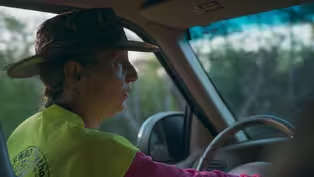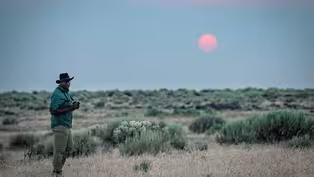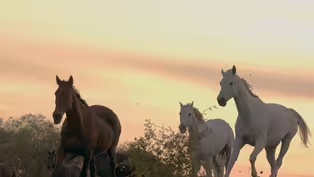
Tracking a Burmese Python with Biologists in Florida
Clip: Season 1 Episode 1 | 4m 5sVideo has Closed Captions
Biologists work tirelessly to radio track Burmese Pythons deep in Florida's marshland.
Brought to Florida as pets, many Burmese pythons have found a perfect home in the Everglades, and they’re spreading fast. As the pythons gain ground, biologists are racing to understand them, hoping to find a weakness and stop the invasion.
Problems playing video? | Closed Captioning Feedback
Problems playing video? | Closed Captioning Feedback

Tracking a Burmese Python with Biologists in Florida
Clip: Season 1 Episode 1 | 4m 5sVideo has Closed Captions
Brought to Florida as pets, many Burmese pythons have found a perfect home in the Everglades, and they’re spreading fast. As the pythons gain ground, biologists are racing to understand them, hoping to find a weakness and stop the invasion.
Problems playing video? | Closed Captioning Feedback
How to Watch Human Footprint
Human Footprint is available to stream on pbs.org and the free PBS App, available on iPhone, Apple TV, Android TV, Android smartphones, Amazon Fire TV, Amazon Fire Tablet, Roku, Samsung Smart TV, and Vizio.
Buy Now

Surprising Moments from Human Footprint
Do you think you know what it means to be human? In Human Footprint, Biologist Shane Campbell-Staton asks us all to think again. As he discovers, the story of our impact on the world around us is more complicated — and much more surprising — than you might realize.Providing Support for PBS.org
Learn Moreabout PBS online sponsorshipBurmese pythons are very cryptic.
They are in the canals.
They are on the levees.
They can be up in trees and underground.
I believe it's right here.
Just off the signal.
Now you know the animals close to sixteen feet long, so it could be in a few places, but if she's in a ball, it's likely right here.
Just off where the signal feels hot.
Prove once again why they have been able to conquer this habitat.
Yeah.
Believe it or not, there's a snake here.
The radio tag doesn't lie.
There's a 16 foot python right under our feet.
We just can't get to it.
Unfortunately, you all have received the typical track experience, and we will have to try another one.
I mean, I think it's like an alien thing, like right it can I mean, they lose teeth and they grow them back.
They have regenerative organ growth so they can actually like their heart can shrink, their stomach can shrink, and then they can grow it back.
This is a vast wilderness with lots of prey.
We've seen everything in their diet, mammals, birds, gators.
Once gators are on the menu, like you've reached official gangster status.
It's just unbelievable.
Burmese pythons eat prey as small as mice and as large as deer and in some parts of the Everglades, these mammal populations have dropped by more than 90% from their pre-python numbers.
#*Indistinct audio#* I hear.
I think you see it in there.
I do.
#*Indistinct audio#* It's moving, I see it.
You see it in there.
Get the camera right in there, you see it?
Want to let her move out.
You ready?
Yeah.
She wiggled out.
Here's a head.
Stay still, stay still.
To touch this animal and feel how muscular the whole thing is.
Can see all kinds of presence back there.
Appreciate the beauty of it, but it's also like this cannot be out there.
I mean but it is.
You want to go on and cinch, cinch the drawstring?
20.1, tear the bag.
It's hard to believe that this ten foot snake is the smallest python we tracked today, after taking measurements and collecting blood.
The team releases the snake back into the wild.
For Christine, that's a necessary evil.
It is a big ask to put them back, right, because you have an invasive in your hand.
Just put it down.
Get it out of the system.
But if we do that, we lose the ability to learn.
The rulebook is is not there for these animals.
It is like driving the car while you're building it in many ways.
The better we understand these snakes, the more likely we are to find a weakness that we can exploit to control them and reduce their impacts.
What is the outlook, is the goal like eradication?
Is that beyond what is possible now?
Trying to manage and mitigate the impacts that they're having is sort of the shifting, shared goal I think.
No, I love the Everglades.
I have to work on this issue.
I can't back away.
As hard as it gets or as frustrating it gets sometimes.
It's too soon to know the ending of this story.
But at least most folks agree pythons should go.
However daunting that sounds.
Once an invader proves that it's here to stay, the question becomes what now?
Cruising the Everglades with a Burmese Python Hunter
Video has Closed Captions
Clip: S1 Ep1 | 2m 46s | Shane’s journey begins in Florida, where he joins Donna Kalil on a Burmese python hunt. (2m 46s)
Video has Closed Captions
Preview: S1 Ep1 | 30s | Shane tracks down four invasive species that make him reconsider what it means to belong. (30s)
The Wild Horses of Nevada's Deserts
Video has Closed Captions
Clip: S1 Ep1 | 3m 4s | Shane ventures into the vast deserts of Nevada to learn about wild horses on public lands. (3m 4s)
Providing Support for PBS.org
Learn Moreabout PBS online sponsorship
- Science and Nature

Explore scientific discoveries on television's most acclaimed science documentary series.

- Science and Nature

Capturing the splendor of the natural world, from the African plains to the Antarctic ice.












Support for PBS provided by:


